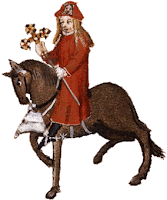 |
| The Summoner - The Canterbury Tales |
Making Medieval Bodies
Thursday, November 19, 2020
Ye Olde Queers: The Role of Homosexuality in the Middle Ages
Wednesday, November 18, 2020
A Clash of Two Communities: "The Man of Law's Tale"
I find that each story in Chaucer’s Canterbury Tales can be recognized for a specific theme or message that the work is trying to portray. What really caught my eye was “The Man of Law’s Tale” and its representation of a collision of two very seperate worlds. It demonstrates what occurs when people from very different communities get entangled, and when faced with religious conversion.
This work is about a super virtuous Catholic woman named
Custance. She is married off into a community of pagans, and undergoes just
about every hardship possible at the hands of two very sinister mothers-in-law.
Despite every adversity that she endures, she is basically saved by her faith,
which remains stronger than ever: “Chaucer authenticates a miracle by asking
why Custance was not slain with other Cristians at the massacre plotted by the
Sultan’s mother (470-71). God saved Custance” (Johnson 5) In the process, she is
able to convert an entire community of people without even trying.
The way in which religious conversion is depicted in the
tale is quite interesting. Chaucer paints Christianity as a religion so powerful
that when one meets a believer who performs a miracle, others will willingly make
the choice to convert. Unlike the original story that the work is based off of,
Lewis states that “Chaucer omits Custance’s role as actively preaching to the
merchants and causing them to be baptized, a move that would seem to result in
a passive rather than an active missionary bride” (14). He focuses the reader’s
attention on Custance as the bearer of faith. Interestingly enough, while doing
this, Chaucer also portrays her as a paragon of faith and purity. She
represents the perfect image of the Catholic Church.
Despite this misrepresentation of Islam that the author depicts, he also seems to hint that the two religions are more alike than different. This is something that both communities in real life may ignore, viewing each other as the enemy. Khan writes that “what is ignored is that the Christians’ belief in the fundamentals and traditions of Christianity is much more similar to the Muslims thinking on their own beliefs” (12). They really are not much different after all, but many refuse to look at the commonalities.
In the original story by Trivet, two main priorities of the Crusades are depicted. These are territorial expansion and the possession of Jerusalem. Interestingly enough, in Chaucer’s version of the tale the main goal is spiritual conversion of the Syrians by the Romans. Islam and Christianity clash in this story, showing its readers the huge impact that this has on both communities. Custance becomes the posterchild for her religion and all things good, while various Muslim characters are written in a completely different manner.
Monday, November 16, 2020
Gender Role Reversal in the Miller's Tale
Painting of Alisoun standing over John the Carpenter
Gender Role Reversal in The Miller's Tale
Furthermore, the gender roles seem to be reversed here since the Male characters are seemingly the ones who are punished for adultery. In the Middle Ages, it was way more common that the woman would more so suffer the consequences of adultery. This is because a man at this time should have proper control over his wife. The male characters are Abolon, Nicholas, and John. In the end, despite being cheated on by John the Carpenter is actually seen as a laughing stock of the town. Absolon punished Nicholas, by sticking a hot stick up his rear, in reaction to Alisoun punishing Absolon tricking him into kissing her rear. The dark humor and love triangle action actually make these characters lose their masculinity in the end. Shannon Forbes writes about Absolon’s lack of masculinity. This is seen when Forbes writes, “Perhaps most seriously, however, Absolon fails to consistently enact the role of the courtly lover because he cannot successfully execute his male authority over the female object of his love” (Forbes 5). Here Forbes suggests that Alisouns’s power seems to stop Absolon from forcing Alisoun to love him.
To sum it up, by using these sources, this project will further prove that the gender roles are reversed in Chaucer’s Miller’s Tale. This is due to the main points that Alisoun exhibits power that women did not typically have in the Middle ages. The power Alisoun has with her choices and rejections causes the male characters to lose their masculinity. This is seen through their inability to love her and their punishments for adultery. Therefore, the gender roles of the female and male characters are swapped in Chaucer's Miller’s Tale.
Sunday, November 15, 2020
Gender Dynamic in "The Wife of Bath's Tale"
Friday, June 5, 2020
Rape and Justice in the Middle Ages
Wednesday, June 3, 2020
Rape Culture in the Middle Ages
 |
| The young, beautiful wife. https://study.com/academy/lesson/the-wife-of-baths-tale-in-the-canterbury-tales-theme-analysis.html |
Homophobic Behavior in the Middle Ages
 |
| http://www.luminarium.org /medlit/pardonport.htm |
 |
| https://uncrcow.tumblr.com /post/179114171134/ how-was-homosexuality- treated-in-medieval-times |


